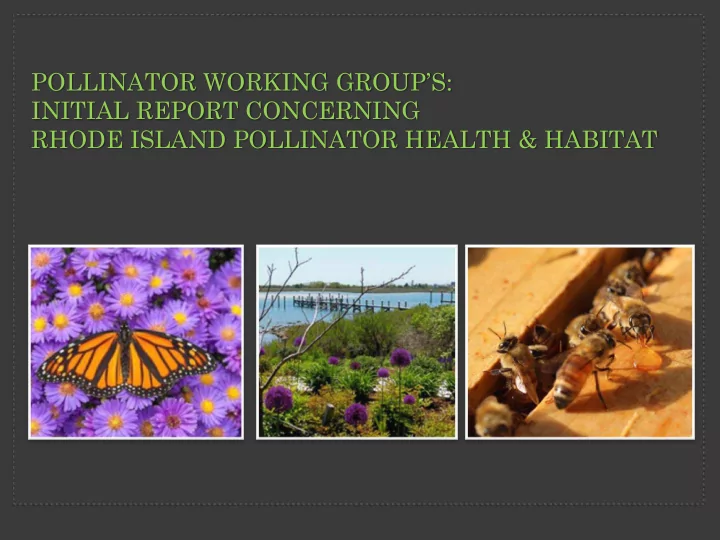

POLLINATOR WORKING GROUP’S: INITIAL REPORT CONCERNING RHODE ISLAND POLLINATOR HEALTH & HABITAT
HISTORY OF THE POLLINATOR WORKING GROUP • Response to legislation and interaction during an educational briefing of the Senate Environment and Agriculture Committee • House Resolution The Charge – Language of the Resolution The Pollinator Working Group (represents a diversity of interests and expertise) RI DEM oversight – Audubon and RINLA served as administrative support
POLLINATOR WORKING GROUP PROCESS • Audubon and RINLA started the process with interviews of each member – issues & experts in the field – Informed the outline and speakers for the meetings • Recommendations begin to appear • Met semi-monthly and weekly meetings – September 2016 to February 2017 • Public participation
SPEAKERS & EXPERTISE • A diversity of speakers and expertise • Providing the PWG with comprehensive look at issues relating to pollinator’s health and habitat • Speakers: Beekeepers RI State Apiary Inspector RI State Biologist Pesticide Regulators Pesticide Industry Representatives Pesticide Educators University Researchers Public Educators
ONE INTERACTIVE SESSION Using the attached label -Figure out how to do the following treatment : Part 1 You have a birch tree you want to treat for birch leafminers. You have equipment calibrated to deliver a flow rate of 0.5 gallons/min. The birch tree you want to treat is 44" in circumference at breast height. You have selected an injection volume of 1 pint per site. • how much Acelepryn do you mix in how much water? • how many injection sites would you use? • where would you place them to treat this tree? Part II If your injection volume per site is 1 gallon and your flow rate is the same (0.5 gallons per minute), 1. how much Acelepryn and how much water do you need to treat this same tree? 2. how many injection sites would you use and where would you place them? Dr. Steve Alm’s Lesson on Rhode Island’s Pesticide Training Program – How to Read a Label
C=2 π r C solve for diameter of tree D = π D treatment =36-D tree solve for diameter of treatment 2 C= π D treatment solve for circumference of treatment
Wild Pollinators of Rhode Island: Inventory, Status, Habitats
Bees 3,500 species north of Mexico 770 species in eastern North America 183 species documented in RI as of spring 2016 a complete inventory would likely double that number
Moths
Flies
Beetles
Bats
Birds Mice
Other stuff: ants wasps spiders true bugs WIND
Butterflies
Why are Pollinators Important ? Certain rare plants are largely dependent on specialized pollinators Pollination is not necessarily an yes-no thing: good pollination improves productivity Certain kinds of pollination are better for certain kinds of plants Other invertebrates as well as vertebrates such as birds and amphibians eat bees. Colletes bees, important native pollinators, also host many parasites and inqualines, such as blister beetles or Epeolus genus of bees.
Pollinators and plant species diversity spicebush swallowtail butterfly Platanthera orchid
Bombus terricola yellow-banded bumblebee Bee decline Apis mellifera, domestic (documented increase in effort required to maintain hives) Apis mellifera, feral (documented decline) Bumblebee species (documented decline) Population (possible, need more data) Species diversity (possible, need more data) Bombus affinis rusty patched bumblebee
nest find a foraging mate for food 1 protection from protection parasites from predators foraging for food 2 hibernation
Bee habitat characters: • flowers • sandy soil substrates • soil surface disturbance • twiggy brush • rodent burrows and matted grass
• Bumblebee nest density coincided most closely with the area of gardens • secondarily with the area of grasslands • elevated bumblebee nest density in gardens was measurable up to 1 km into adjacent farm lands with poor bee habitat
For bees, URBAN does NOT necessarily equal BAD Domesticated bees and wild bees can thrive in urban settings Also great for connecting with large numbers of people
THREATS TO POLLINATOR HEALTH • In the past state bee programs recognized the threat from disease (primarily American Foul Brood) • Threats have multiplied many times over while capacity to manage has steadily diminished: European Foul Brood, small hive beetle, varroa mite, nosema Pesticides more widely distributed, effects of stacked pesticides, sub-lethal residue in pollen, wax and bee bread Habitat Loss – decline of pasture land, more intensive agriculture, removal of field weeds with herbicide Industrial Agriculture – monoculture plantings (i.e. corn, potatoes) Industrialized bee keeping including long-distance transport
THE POLLINATOR WORKING GROUP’S PRELIMINARY TOP TIERED RECOMMENDATIONS The preliminary recommendations are organized into 4 groups: Regulatory Programmatic Knowledge Gaps Public Education There is category overlap in the recommendations
REVIEW OF RECOMMENDATIONS
THANK YOU For more information go to RI DEM Website: http://www.dem.ri.gov/programs/agriculture/pollinator-working-group.php
Recommend
More recommend